#split attraction model
Text
idk but no aspec person is required to use the split attraction model if they don't want to. No one is required to define their asexuality or aromanticism or grey-aceness or demisexuality in a way that makes you comfortable.
Not being into romance or dating or marriage *is* actually an asexual experience.
Not being into sex or kissing or similar *is* actually an aromatic experience.
An aspec person tagged a post that you would define as an aromatic experience with #asexual? Yeah, it probably is for their asexuality. An aspec person tagged a post that you would define as an asexual experience with #aromantic? Yeah, it probably is for their aromanticism. You don't get to control other people's orientations. If it bothers you, tough titty, either get over it or put a dni on the post saying you don't want specific aspec people to interact with the post.
23 notes
·
View notes
Text
aspec terms for beginners!
since it's trending right now, i feel like it might be helpful to clear up some basic aspec (but particularly aromantic, as we are the center of attention currently) terms. if you have absolutely any questions, i would be happy to answer, either in the replies, dms, or my inbox!
★・・・・・・★
the split attraction model (SAM): a model of human behavior that posits that, for some people, romantic and sexual attraction are not the same.
[most often this will come in the form of someone being aspec on one axis and allo (not aspec) on another. for example, a biromantic asexual may be romantically attracted to two or more genders, but sexually attracted to none. some people may even use SAM for allo identities– a bisexual lesbian may be sexually attracted to multiple genders, but only romantically attracted to women (note that this is not the only way that someone can be an mspec lesbian, just one way!). the SAM does not apply to everybody, not even all aspecs! there are non-SAM aros, for instance, who do not differentiate their aromanticism from their sexuality.]
aspec: a collection of queer spectrums centered around the lack of a certain attraction or identity. the most common spectrums under the aspec umbrella are asexual, aromantic, agender, and aplatonic, though there are many other ways to be aspec.
asexual: experiencing little to no sexual attraction.
[aces can still have sex– whether its because they experience some amount of sexual attraction or they just want to participate in sex because they find the act appealing in some other way. that being said, there are still plenty of aces who have not and will never have sex. it is a spectrum.]
aromantic: experiencing little to no romantic attraction.
[aros can still have romantic partners– whether its because they experience some amount of romantic attraction or they just find relationships appealing in some other way. that being said, there are still plenty of aros who have not and will never be in a romantic relationship. it is a spectrum.]
agender: having no gender or little relation to any gender.
aplatonic: experiencing little to no platonic attraction.
[similarly to aros and aces, apls can still form friendships if they so desire– whether its because they experience some amount of platonic attraction or they find friendships appealing in some other way.]
aroallo: combination of aromantic and allosexual– allosexual being someone who fully experiences sexual attraction. an aroallo, then, is someone who is aromantic but not asexual. aroallos often do not have a standard relationship with sex due to its romantic connotations and the stigma against loveless sex. someone having sex with someone else they do not love does not inherently make them aroallo, much in the same way that having a nonsexual relationship with a partner doesn't inherently make either participant asexual.
aroace: someone who is both aromantic and asexual. because aro and ace are both spectrums, an aroace may still experience some amount of attraction on either or both of those spectrums, or they may experience attraction of some other kind (platonic, tertiary, etc.), and that attraction may be only for a certain gender or genders– these are known as oriented aroaces.
queerplatonic relationship: a type of relationship that is defined only by the people within it. i have a post dedicated to explaining this in larger detail.
partnering: an aspec (usually aromantic) person who has and/or desires to have a partnership or multiple partnerships– romantic, queerplatonic, or otherwise.
non-partnering: an aspec (usually aromantic) person who has no desire to form a partnership of any kind.
romance/sex/plato favorable: an aspec who desires or would not reject a romantic, sexual, or platonic relationship. they are also generally not particularly bothered by seeing these relationships in their day-to-day.
romance/sex/plato repulsed: an aspec who does not desire a romantic, sexual, or platonic relationship and generally does not like seeing those relationships in their day-to-day. [x] repulsed people are not necessarily judgemental towards people who desire or participate in those relationships, they just do not desire them for themselves. repulsion often takes the form of discomfort or annoyance. [x] repulsed people are not necessarily cruel sticks-in-the-mud– they are perfectly capable of being respectful, and they very often are. repulsion does not always stem from trauma, though it certainly can.
romance/sex/plato positive: not to be confused with favorability, [x] positivity is the belief that romance, sex, and platonic relationships are human rights that should be supported and uplifted. someone can be [x] repulsed and [x] positive at the same time, because favorability/repulsion revolves around the self, and positivity/negativity extends to others.
sex/romance/plato negative: not to be confused with repulsion, [x] negativity is an inherently judgemental and harmful ideology. most commonly in the form of sex negativity, these ideologies are centered around the opposition to or personal judgement of people who engage in romance, sex, or platonic relationships. sex negativity in particular is embedded in western white supremacist societies and it is important for aspecs not to play into that.
those are the basics, but i have more information below the cut!
★・・・・・・★
> how are aspecs queer?
aspecs are queer because "queer" does not only mean LGBT. queer theory is about far more than just LGBT people– though they are undeniably a large part of it– queerness is any subversion of the traditional cisheteronormative standard. this includes things that cishets may take part in/identify with, because you do not have to be LGBT to subvert those standards. cishets who are gender-nonconforming are queer, for example. a good rule of thumb is that if you have to explain what you whole deal is to cishets, you're queer. queer does mean strange, after all.
traditional cisheteronormative conceptions of attraction, gender, and relationships do not account for aspecs. it is expected that everyone will one day form a traditional partnership with one other person, and that relationship will include sex (even if only for procreation, under some dogmas). virginity past a certain age is seen as a point of shame and something indicative of a larger problem in someone– in men, a red flag even. people past 30 without a relationship are pitied. our economic structure is build for couples and families– it's near impossible for someone to live comfortably alone. romance, friendship, and love are placed on a pedestal, treated as the meaning of life, the best thing anyone could ever experience. "love is the point of everything," as many posts on this site like to claim. people who reject these ideas are undeniably queer.
> i can get behind aros and aces, but the whole "aplatonic" thing feels like a stretch to me. how is not having friends queer? "platonic attraction" isn't even real.
aplatonicism is more than just "not having friends," and many apls have friends anyway, much in the same way that aros can date and aces can have sex. someone who does not have friends is not inherently aplatonic, they only are if they identify that little-to-no platonic attraction in themselves and choose to label themselves that way (just like how virgins aren't inherently asexual). still, apls who don't have friends exist, and they are all queer. what is a greater subversion of traditional cisheteronormative relationship structures than an outright rejection of what's seen as the most basic, fundamental relationship our culture has to offer?
you may not feel that platonic attraction is a distinct phenomenon in your own experience, and that's fine! ultimately, a lot of aspec terms exist for the utility and comfort of aspecs themselves. the SAM isn't for everyone, and platonic attraction isn't for everyone either. you do not have the authority to tell people what their own experiences are, nor should you care.
> i think it's sad that you're limiting yourself with these labels. you'll find someone one day!
for the broad majority of aspecs, our identities are not self-disciplinary, nor are they necessarily permanent. all queer people are capable of misunderstanding their identity or having a fluid identity– it is not a problem unique to being aspec. that being said, a lot of us may always be aspec and completely happy with it. being aspec is not a tragedy. the only thing i don't like about being aromantic is the judgement i receive from other people about it. non-partnering aspecs are not "missing out" on anything, because we don't even want the things we're rejecting in the first place. many of us are romance/sex/plato repulsed and are far more happy engaging with the world and with other people in different ways, because there is so, so much more to life than relationships, and it's wrong to presume that relationships are universally fit for everybody. telling an aspec that they'll find "the right person" one day is no different from telling a lesbian she'll find "the right man" one day. there is no "right person" for an aspec just as there's no "right man" for a lesbian. a lesbian is not "missing out" on a heterosexual relationship just because it's culturally perceived as superior and more fulfilling.
[disclaimer before anyone tries to do a "gotcha," i'm talking about a lesbian who is fully not attracted to men in any way. it's not like homophobes know the intricacies of gender identity and nonconformity as it pertains to homosexuality anyways.]
lastly, i wanna give a special shout out to the loveless aros and the relationship anarchists.
loveless aros are those who either feel little-to-no love as they understand it, or they are someone who supports the de-centering of love. they're worthy of a whole post of their own, but in summary: the loveless experience is all about finding joy in yourself and the countless things our world has to offer that are not dependent on the vague idea of love.
relationship anarchy is another concept worthy of its own post, but in essence it's an ideology aimed at abolishing the standard hierarchy of relationships (in the USA, depending on who you ask, its typically friendship < family < romantic partnership or friendship < romantic partnership < family) and allowing everyone the autonomy to define their relationships for themselves.
if i made any mistakes, let me know! and of course i'm willing to answer any questions anyone may have. :-3 thanks for reading my long ass post!
#barking#aromantic#aspec#romance repulsed#aroallo#aplatonic#asexual#aroace#loveless#queer#lgbt#queerplatonic#alloace#queer theory#relationship anarchy#split attraction model#aro#ace#apl#agender#long post
2K notes
·
View notes
Text
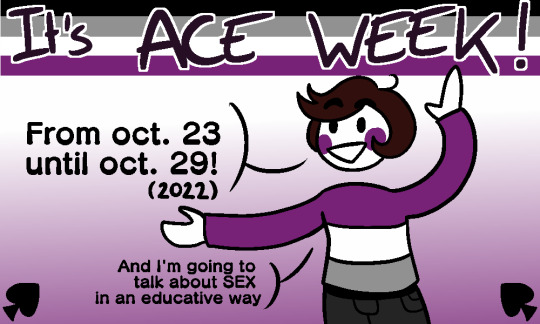

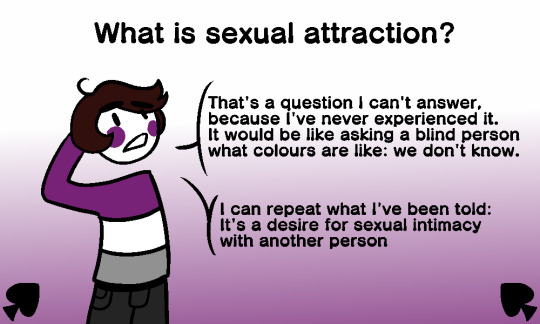


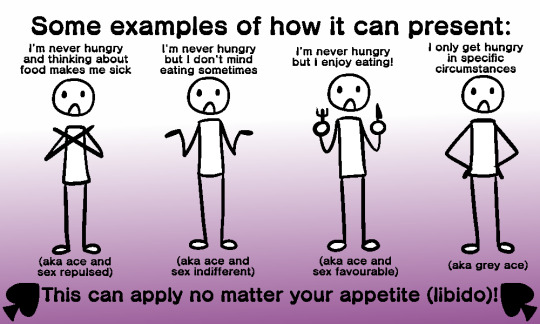
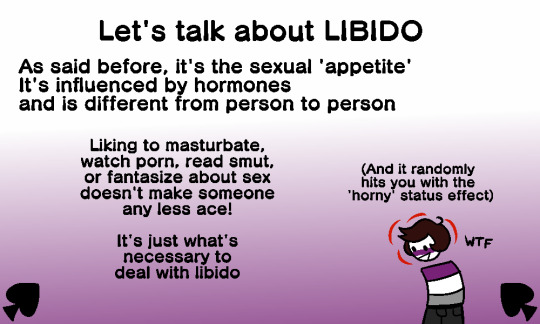
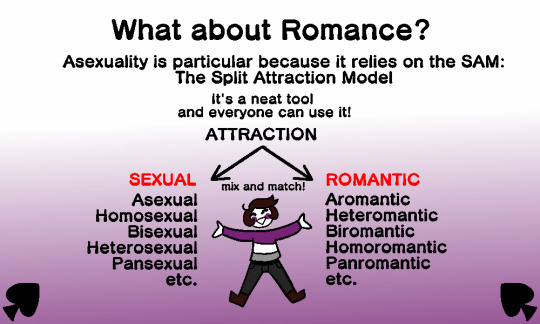
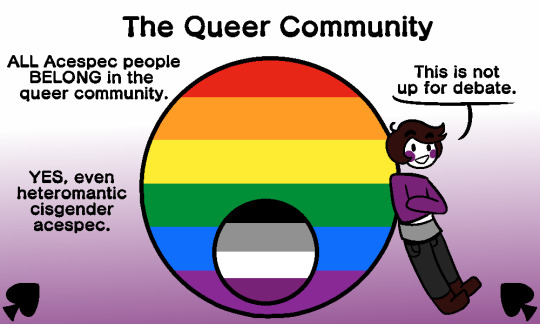

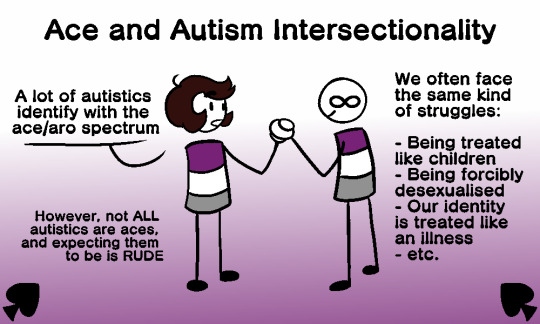
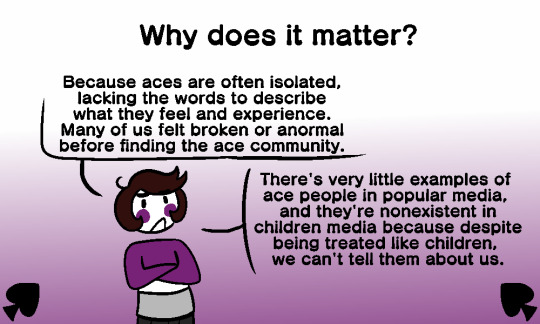
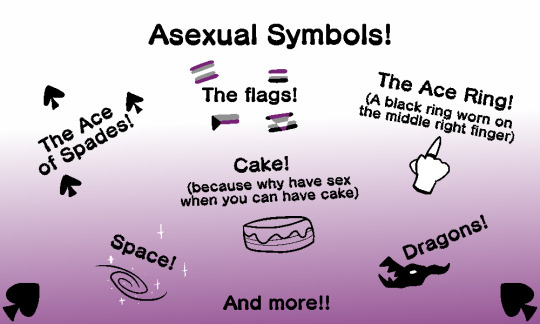

IT IS ACE WEEK!
So let's talk about asexuality! This is an introduction trying to cover as much as possible in a little format, so its mostly surface level stuff. You're gonna have to dig on your own :P
For more information, I recommend checking out aceweek.org or acesandaros.org ! You can also read up on ace history through the Asexual Manifesto by Lisa Orlando !
Edit: Here are some links for more information:
Aceweek
AcesAndAros
An article about the Asexual Manifesto that links you to a transcript
An article about Asexuality's history
#ace#ace week#asexual#asexuality#actually asexual#aspec#acespec#asexual spectrum#aromantic asexual#ace pride#split attraction model#autism#asexuality 101#sex ed#i guess?#LBArt#i finally did something for ace week#i am so proud of myself#pap pap
21K notes
·
View notes
Text

Sensual attraction got me questioning my entire life rn (could also have used the "is this a pigeon?" meme but oh well)
#aroace#questioning#queer#aromantic#asexual#i might be gay. whoops#tertiary attraction#split attraction model
841 notes
·
View notes
Text
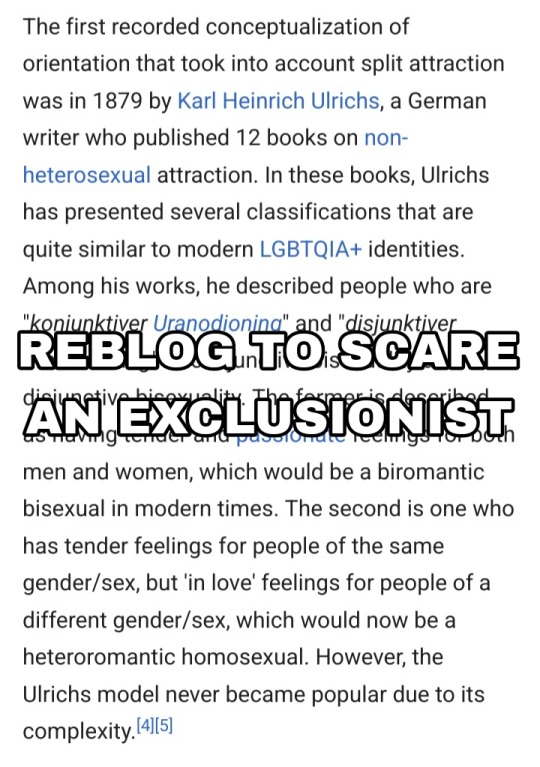
posting this on it's own
#max squawks#critinclus#mspec mono#mspec lesbian#mspec gay#mspec straight#bi straight#bi gay#bi lesbian#sam#split attraction model#anti exclusionist#anti exclus#anti exclusionism#contrapunk#contradictory labels#heteroromantic homosexual#homoromantic heterosexual
726 notes
·
View notes
Text

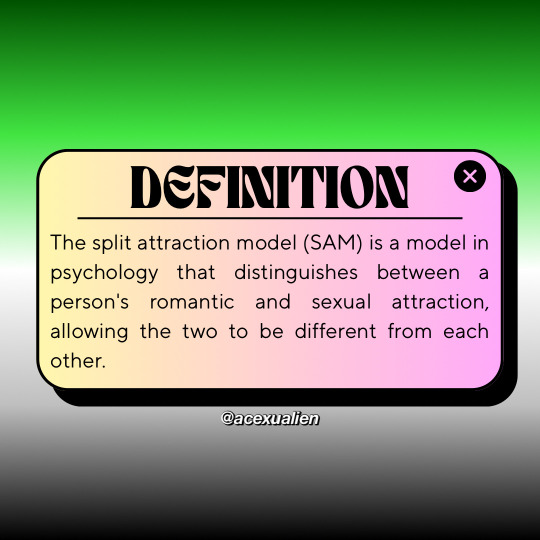
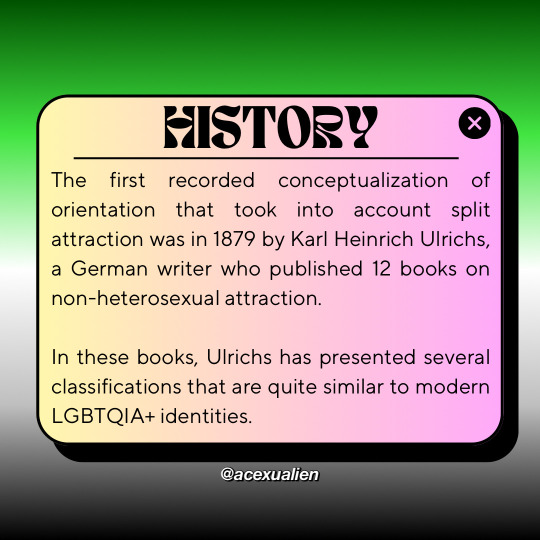
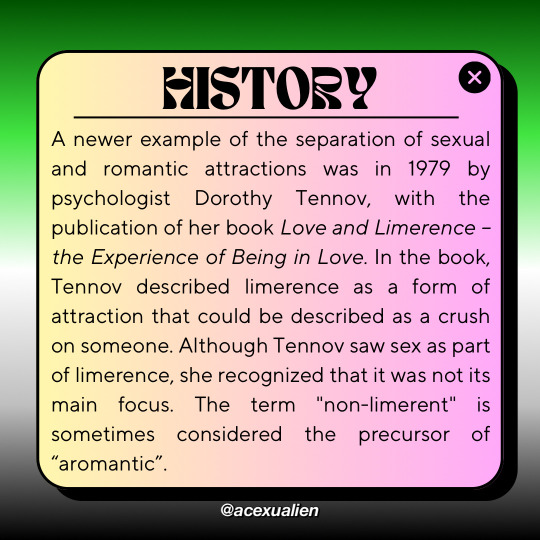
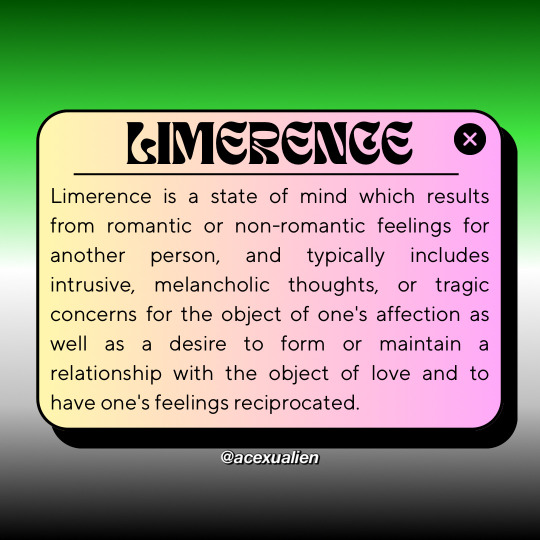


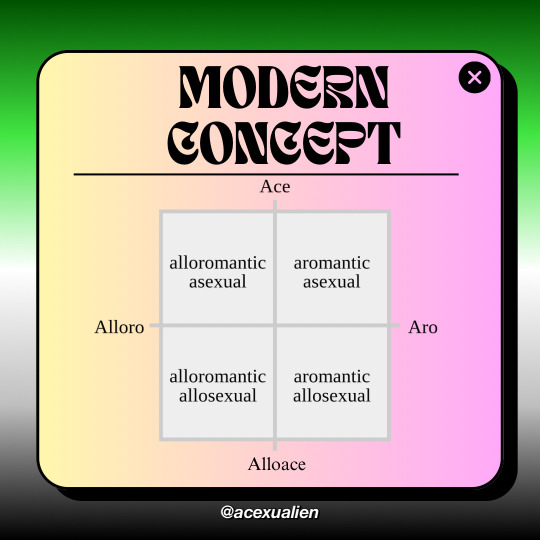

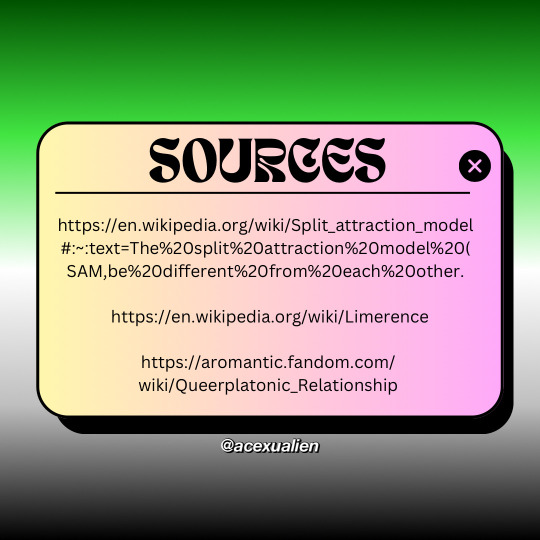
#sam#split attraction model#aromanticism#aro#aromantic#aro pride#aro positivity#aroace#aspec#asexual#asexuality#ace#demiromantic#greyromantic#acespec#asexual pride#aromantic pride#info post#education#queer#lgbtqia+#lgbtqia#queer pride#aromantic asexual#asexual aromantic#aromantics#aro awareness#aromantic awareness#asexual awareness#aromantic spectrum awareness week 2024
236 notes
·
View notes
Text
HOLD TF UP how is no one talking about the fact that the Elves have literally normalized the split-attraction model?? Heck, Tyril and Kaya have their own version of a QPR. Plus, the fact that Kilvali can mean either romance or friendship, puts both relationships on the same level of emotional intimacy!
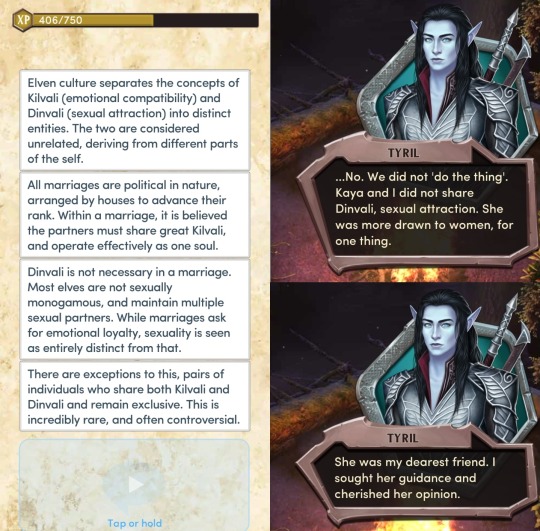
None of that amatonormative belief that "romantic relationships are deeper than friendships" or that stupid phrase "more than friends". None of the "romance and sex are important in a marriage" crap. Hey humans, can we please adopt this stuff? BOLAS elven culture is SO aspec friendly its insane.
#you can find details in your replays that you missed in your first playthrough#my first playthrough was years ago#blades of light and shadow#bolas#choices memes#bolas memes#playchoices#choices#tyril starfury#asexual#aromantic#aroace#aspec#qpr positivity#qpr concepts#split attraction model#amatonormativity
314 notes
·
View notes
Text
The split attraction model is for everyone, not just aspecs. It is important to center its history in the aspec community as to not forget the hell aspecs got for its creation and usage. But we should not stop non-aspecs from using it as it is an important model and way to break the stigma of romance and sexuality being inherently connected.
1K notes
·
View notes
Text
So... I'm doing research for a piece of creative non-fiction (a personal essay) I'm writing for one of my uni assignments about the fact that I'm asexual and demiromantic and think that we, as a wider society, have gotten the concepts of love and attraction all wrong, and I've been researching more into the split attraction model because, well, I see it as something that's important and relevant, and this came up in my Google search:

The initial red flag of this article is the fact that it's on BetterHelp. I didn't see this at first, and did a double take.
Anyway, the first thing I would like to ask is: what are these 'cons'? As far as I'm concerned, there are none. I understand that, for many people, romantic and sexual attraction are intrinsically linked, but, for many, they're not, and the split attraction model existing doesn't harm the former - it helps the latter. The latter includes people who are on the asexual and/or aromantic spectrums, as well as people who are, for example, heteromantic and bisexual, panromantic and homosexual, biromantic and heterosexual, etc. - basically anyone whose experiences differ between their romantic and sexual attraction.
I do find it a bit annoying that, when many people talk about both of these kinds of attraction, they lump them into one 'label', which is mostly [something]sexual (e.g. heterosexual, homosexual, etc.). But, for them, the two are linked, so referring to themselves as [something]sexual to cover both seems fine and dandy. Which... it is. However, I find it wild that people don't realise that, despite the fact that the two may seem linked to them, they are actually two different experiences. People who are both alloromantic and allosexual should be able to see this, right? They can think someone is sexually attractive yet not be romantically attracted to or want to date them. That is a thing that can happen.
Anyway, I decided to read through the article. It isn't bad, per se - much of the information is useful, and it seemed to be quite positive. Until I got to the 'cons':
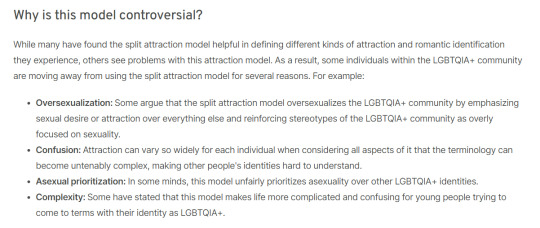
Now, I'm not really into the discourse surrounding the split attraction model - in fact, I didn't realise there was discourse surrounding it. This is because I tend to, either accidently or on purpose, avoid discourse in general. But... 'oversexualisation'? In what context? If anything, not using the split attraction model would be considered 'oversexualisation' (even though I don't think that that is, either - I honestly don't know why this word has been brought up here) due to the fact that many people focus on sexual attraction over any kind of attraction and use it to cover romantic attraction, too, when they talk about it. I genuinely have no idea what they are referring to here.
In regard to the second point: what? Attraction is complex. That's the whole thing. The split attraction model makes it less complex for many people. It allows people to figure out who they are and have the terminology to be able to voice it. Attraction is a spectrum and so is gender. Of course both of them are going to be complex. Society made both of them rigid in the first place, so breaking out of those rigidities is going to be confusing for everyone. The split attraction model helps people understand themselves, and I would like to think it helps them understand others. Everyone benefits.
I don't know if I can speak much on the third point, as I'm not familiar with the discourse, as I previously mentioned, and don't really know what it entails. Though, in saying this... what do they mean? When has asexuality - or aromanticism, for that matter - ever been prioritised over other queer identities? There's a severe lack of discussion and education surrounding both of them. That's just a fact. People who are asexual and/or aromantic are oftentimes even shunned by the wider queer community they are a part of. I don't really have much more to add on this point because I'm so confused by it. By the way, this article barely talks about aromanticism, despite the fact that it's an important part of this model, too.
The last point is just a rehash of the second point. If I was told about any of this stuff growing up, I would have realised I was ace and demiromantic from the start. Instead, I realised I was ace a few years ago after watching Jaiden Animations' video about the fact that she's aroace (I don't want to use the term 'coming out' here because, frankly, I hate it - I'll save that rant for another time). I only realised I was demiromantic in the past month after... realising that people getting romantic crushes on and/or falling in love with someone when they barely know them is actually a thing that happens and isn't fake. These two terms fit me best at the moment, and explain everything. If I had've known these terms as a teenager, that would have been great. The split attraction model helped me so much in breaking down myself and my identity, and offered me the foundation I needed to ask myself questions. Yeah, attraction and gender are confusing - I said it before, and I'll say it again. But why would you cast something so helpful aside? That will only hinder people - both those who are struggling with their own identity and those who are trying to understand the identities of others. Education surrounding the complexities and spectrums of attraction and gender are so important, and this model will help people teach other people about attraction.
I also read a bunch of hate comments, as one does whenever they go on Reddit or Twitter or literally any social media platform ever, regarding the split attraction model. This didn't surprise me. These specific people seem to hate this model because... well, I don't really know. They were mostly spewing aphobia. I don't think a single one had a constructive point. Also, most of the search results for 'split attraction model' on Google are actually critiques of it, or articles talking about critiques of it and being on the fence. Come on, people. Do better.
Anyway, the split attraction model is important. Education is important. Allowing people to figure out who they are and express it is important. This should all go without saying.
That is all.
#my ramblings#my writing#i want this out there somewhere so i'm actually tagging multiple things for once in my life#asexual#aromantic#aroace#ace#aro#lgbtqia+#split attraction#split attraction model#uhhhhhh#i don't know what else to tag#if you've read this far... hi#edited because some of the sentences didn't flow as well as i wanted them to lmao
171 notes
·
View notes
Text



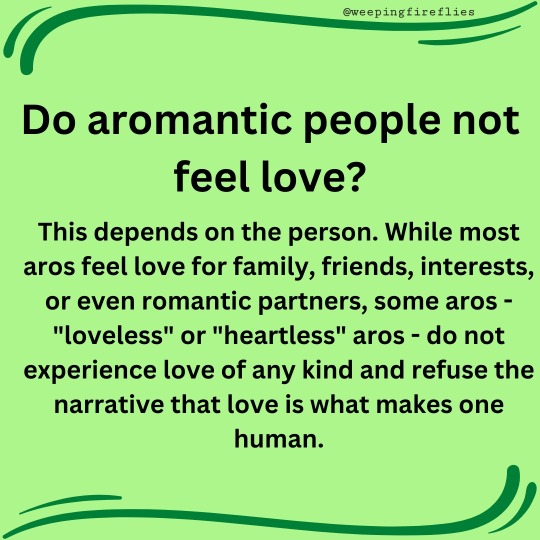



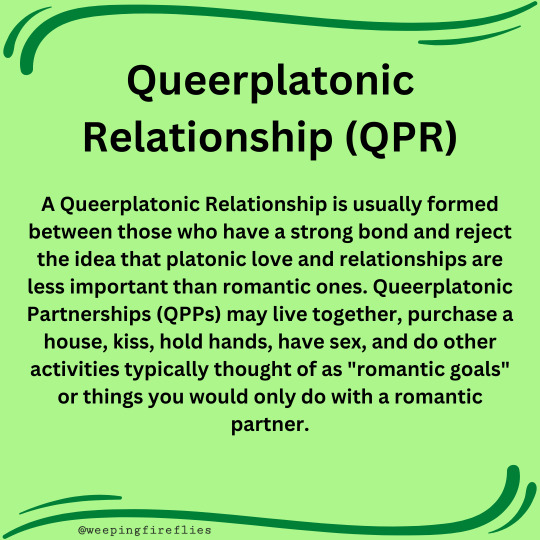

Split Attraction Model (SAM) & More on QPRs
Edit: Thanks to @klavierpanda for correcting me! Romance-positive is supposed to be romance-favorable. I can't edit the photo right this second, but I will when I get a chance.
#asaw 2023#asaw#aromantic spectrum awareness week#aromantic spectrum awareness week 2023#aromantic#aro#I couldn't really include all I wanted on SAM/non-SAM aros or QPRs#SAM is the aroace / alloace / aroallo identities#informational#information#SAM link - the psych2go vid is very helpful (but doesn't explain SAM specifically)#QPR link - the first paragraph explains it the best/has the best summary#queerplatonic relationships#qpr#split attraction model#image described#my posts#infographic#lgbtqia#lgbtqia+#lgbt+#edit#they also mentioned other relationships than QPRs but I can’t find info rn
1K notes
·
View notes
Text
hi not so friendly reminder that this blog is inclusive of aros and aces. yes, even cishet aros and aces.
I really hate how I have to make a post like this.
cishet aros and aces are still queer *because* being aro or ace (or aroace) is queer. queer is not the same thing as "not cishet". and if you think otherwise get off my blog and never come back until you've unlearned your aphobia.
thanks.
(OP is a minor. Don't be weird)
#asexual#aromantic#yes this is in reply to that one poll (in which i will *not* be reposting for obvious reasons)#aspec#non sam aro#non sam ace#split attraction model#anti-exclusionist#EDIT 2: it's been a while so reblogs are on again!
377 notes
·
View notes
Text
Learning about the split attraction model for me was a game changer when realising I was ace. It made me appreciate that there were other types of attraction and what I was experiencing was actually aesthetic. It also means that I can completely separate the asexual side of me from the aromantic side of me. Even though my sexual and romantic orientations are the same, I see them as two separate identities. I don’t know why but the asexual part has always felt more meaningful to me but maybe that’s just because it was my first-born identity
#asexual#aroace#aromantic#ace#aro#ace pride#queer#lgbtqia#asexuality#asexual spectrum#split attraction model#acespec#ace spectrum#aromantic spectrum#arospec#ace umbrella#aspec#aesthetic attraction
1K notes
·
View notes
Text
Let’s talk about what demisexuality
Very basically, demisexuality describes a sexual orientation in which a person does not experience sexual attraction to anyone of any gender unless a close bond is formed. This does not mean they are attracted to everyone they are bonded with, nor is it just abstaining from sex.
Abstinence is a choice anyone of any sexual orientation can make, and is a choice about sexual behavior. Celibacy is also a choice anyone of any sexual orientation can make, and is a choice about sexual behavior. Both are often confused for asexuality, but asexuality is a sexual orientation which describes a spectrum of little to no sexual attraction, and sexual behavior for aces can vary from ace to ace.
Demisexuality describes how attraction is formed, rather than who it is towards. For this reason many demisexuals choose to delineate their romantic orientation separately. For example if I’m romantically attracted to the same gender, I would be a homoromantic demisexual.
This is predicated on the idea of splitting romantic, sexual, and even tertiary attractions via the Split Attraction Model, or SAM. While many demisexuals us the SAM, not all do nor is it required.
Demisexuals can be any romantic orientation. This means a demisexual may or may not be aromantic or alloromantic. Demisexuals aren’t necessarily demiromantic; demiromantics aren’t necessarily demisexual.
Demisexuality exists under the spectrum of asexuality because it describes sexual attraction that is only experienced under a specific condition and context. The term originated on forums discussing the gray area of asexuality on @avenpt forums between 2003-2006. The rumor that it was started for a fictional character for a role play isn’t true; the link in this paragraph has citations and screenshots showing where it was originally coined.
Being demisexual doesn’t automatically mean that you’re sex favorable. This misconception stems from the idea that “all women are demisexual”, which misconstrues the spectrums of gender and asexuality, and also robs allosexual women and feminine people of their sexual autonomy. Choosing to not have sex until you trust the person isn’t the same as not experiencing sexual attraction to anyone at all until a specific bond forms, and not with every bond. The perception that only women would ever wait until there’s trust to have sex isn’t true either; anyone of any sexual orientation and gender can make that choice.
The more common misconceptions about demisexuality, and asexuality as a whole, are largely based in ideals around conservative Evangelical Christianity; that is to say the heteronormative notion that women and feminine people are inherently “more” asexual than our male counterparts. This is false. Not only is demisexuality’s existence (and asexuality’s existence) not predicated on gender, it is an experience of conditional sexual attraction, not sexual behavior or action. This view is dehumanizing and plays into seeing women and feminine people as objects whose sexuality only exists for the pleasure of others instead of complex people. In addition it boils men and masculine people down to only desiring sex for its carnal pleasure, rather than viewing them as whole people, and erases the experiences of ace men and masculine people.
Anyone can be ace; anyone can be demisexual. Aces can also have and enjoy sex for a variety of reasons. While many don’t have sex, it’s not true as a rule. Aces can have and enjoy sex, or not have sex at all.
I hope if you’re demisexual, you’re having a great day and you feel valid about yourself! Because you are.
#demisexuality#demisexual#demisexual pride#asexuality#asexual#asexuality spectrum#asexual spectrum#asexual stuff#lgbtqia#queer#split attraction model#sexuality#text#scretladyspider writes#ace#acespec
1K notes
·
View notes
Text
its okay to not use the split attraction model to figure yourself out btw. if you even care
109 notes
·
View notes
Text
the common phrasing, “more than friends” is typically used by alloromantics, because even if they do not fully have the language to understand or express it, many of these people are experiencing romanticism on top of platonicism. in this essay i will-
#aka: allos already understand split attraction‚ and therefore should be able to understand aplatonicism‚ alloaros‚ and alloaces.#thank you for your time#alloaro#apl#aplatonic#split attraction model#alloace#in this essay meme#romo aro#they speak#tags#rambles#aro#aromantic#aroace#aro spectrum#arospec#alloapl
1K notes
·
View notes
Text
Sims recognizing asexuals, aromantics, and split attraction peeps, and implementing a system to make these identies (among many others) officially recognized in game? Yes please.
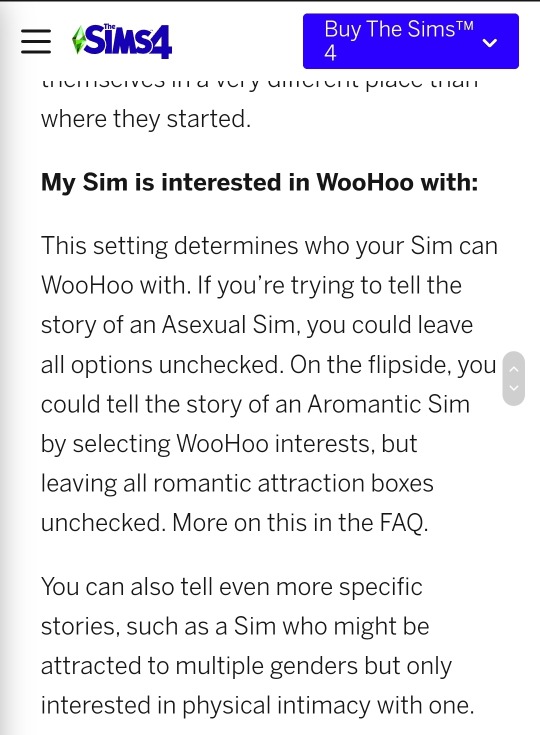

#ace#asexual#ace pride#asexual pride#lgbtq#lgbtqia#lgbtqia+#lgbtq pride#acespec#asexuality#aromantic#aro#arospec#aromanticism#aroace#aroallo#alloace#sam#split attraction model#sims#sims 4#the sims 4
2K notes
·
View notes